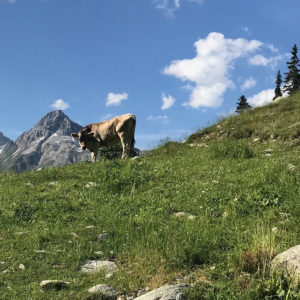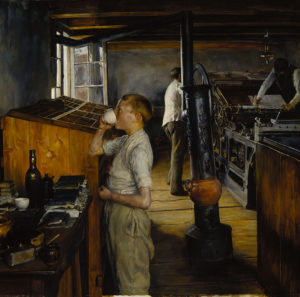Hurricane Dorian kicked us a bit out of sync as we transitioned from August to September, but here, finally, is your printable Convivio Book of Days calendar for September. We are fine here in Lake Worth, though that is not the case with our neighbors in the Bahamas. Just 75 miles east of us is the western point of Grand Bahama Island, and I can’t tell you how many times I’ve scanned the horizon at the coast when I was a boy, looking for the Bahamas because they’re right there, but 75 miles is a distance sometimes. Enough of a distance to see no sign of land from here, and enough of a distance for us to emerge unharmed by Dorian’s course.
That’s how I got to Maine the first time I went to that fair state. I was going to Penland, North Carolina, but I had some artwork to bring to a gallery in Vermont––my first non-academic art show––and, on the map, at least, Vermont seemed to be just a little further away. Why not bring the artwork there myself? And if I was going to Vermont, I figured, certainly I should go to Maine. This is the way my mind works. You can see how someone like me would be looking out over the Atlantic, hoping to see Grand Bahama from my tiny strand of sand.
Way over in Switzerland, it’s the time of year the cows come home from the Alpine meadows. They were there last July when Seth and I were driving along the Splügen Pass on the way from Austria to Italy, high in Alps, their bells ringing through the mountain air as we drove, and now that winter is setting in, it’s time for them to come down to the valleys. Typically this happens now, in early September, and especially on the 8th of September, which is the day we celebrate the Nativity of Mary, which is known as Drive Down Day in some parts of Switzerland. The return of the cows is not without some pomp and ceremony: they’re dressed up and decorated and so are their human companions. It’s a sight, I’m sure, but it’s the bells I love best. If you’ve never heard them, well… it’s the most peaceful sound. One of those bell-wearing Swiss bovines is the cover star of your September Book of Days… and while we’re at it, here’s a video we took when we were in Switzerland of the cows and their bells, not long before we reached the top of the Splügen Pass:
Across the border in Italy the folks like to eat blueberries today: blue, the color of Mary’s cloak, at least in Italian Renaissance paintings. Lights are illuminated in windows, and bonfires blaze. In France, Mary is celebrated today, in the midst of the grapes ripening on the vine, as Our Lady of the Grape Harvest. Bunches of grapes are brought to churches for the priests to bless and you’ll find lots of grapes this day in the hands of statues of Mary, placed there by Marian devotees and by lovers of wine and by traditionalists like me. This is September, the first of the “Ember” months. Seth and I, we wish you a fine one.
COME SEE US!
We’re popping up at Hatch 1121 in Lake Worth on Saturday for the big “Catrinas: The Festival” event and I’m teaching a workshop at the Armory later this month.
CATRINAS: THE FESTIVAL
Saturday September 14 from 4 to 9 PM
Hatch 1121 (the old Lake Worth Shuffle Board Courts)
at 1121 Lucerne Ave in Downtown Lake Worth’s West Village
Our favorite time of year is fast approaching! Here, to kick things off, Lake Worth meets L.A. in a unique festival that revolves around an exhibition featuring works by Lake Worth artist José R. Mendez and Los Angeles photographer Gus Mejia. Admission is free and plentiful parking is nearby. In the Hatch courtyard, live mariachi, food, crafts, and low riders… and we’ll be there in our usual spot with a preview of this year’s Convivio Bookworks Dia de Muertos collection. You’ll find your old favorites plus lots of new items not yet in our online catalog, all of them made by hand by artisans in Mexico. It’s all about authenticity.
WORKSHOP: INTRO TO BOOK ARTS
Saturday September 21 from 9:30 AM to 4:30 PM
The Armory
at 811 Park Place in West Palm Beach
Printing and bookbinding are at the core of the Book Arts, and in this one day workshop, you’ll get a foundation in both. Learn a bit of letterpress plus the techniques behind a range of handmade book structures that you can create anywhere on your own without special bindery equipment. We’ll print one of our book covers from handset type, and you won’t just leave with blank books: one of the books you’ll bind is a letterpress limited edition story that was printed by your Convivio Bookworks boys in years past, and you’ll get to bind your very own copy.



